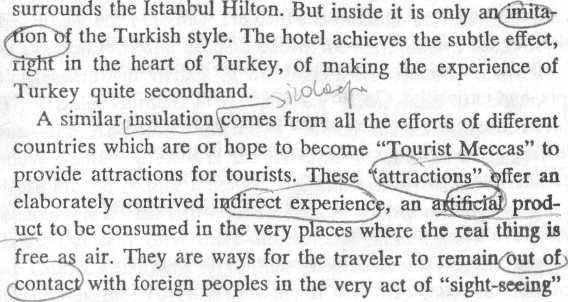boorstin13
ę g From Trayeler to Tourist:
Hilton changed his slogan from “Across the Nation” to “Around the World.” The Caribe Hilton in San Juan, Puerto Rico, opened in 1947, the Castellana Hilton in Madrid in 1953, the Istanbul Hilton in 1955—-and these were only a beginning. By 1961 Hilton Hotels were also operating in Mexico City and Acapulco, Panama City, Montreal, Cairo, West Berlin, St. Thomas (Virgin Islands), Santiago, and Honolulu. There were associated hotels in Sydney, Melbourne, and Queensland. Hotels were under construction in Port-of-Spain (Trinidad), Athens, Amsterdam and Rotterdam, London, Teheran, and Romę, and projected in Paris, Mayaguez (Puerto Rico), Tokyo, Addis Ababa, Bogotś, Dorval (Quebec), and Tunis.
The spirit of these new hotels was well expressed in Conrad Hilton’s own account of the Istanbul Hilton opening in 1955, to which he brought a planeload of American celebri-ties and news makers. “When we flew into Istanbul for the opening with our guests from America, Carol Channing, Irene Dunne and her husband, Dr. Francis Griffin, Mona Freeman, Sonja Henie, Diana Lynn, Merle Oberon, Ann Miller, repre-sentatives of the American press, John Cameron Swazey, Bob Considine, Horace Sutton, Louella Parsons, Hedda Hopper, and Cobina Wright, not to mention my very old friend, Leo Carillo, who once owned a deer named Sequoia, there is no question but that we all felt the antiquity, romance and mystery of this ancient city. ... I felt this ‘City of the Golden Horn’ was a tremendous placebo plant a little bit of America.” “Each of our hotels,” Hilton announced at the opening, “is a ‘little America.’ ”j
I have been Tn both the Caribe Hilton and the Istanbul Hilton and canjsstify that both are models of American tuod1-Jmjty and ąntisepsiśy They are as indistinguishable in interior feeling ahd~deśign as two planes of the American Airlines. Except for the views from the picture Windows./you do UloMcnow where you are. You have the comforting feeling of notreally bemg therei Even the measured admixture of care-
The Lott Art of Travel fułly filtered local atmosphere proves that you are still in the U.S.A.
^ CAU ^
The self-cons^ious effort to provide local atmosphere is itself thoroughly jAmerican. And an effective insulation from the place where you have gone. Out-of-doors the real Turkey

them. They keep the natiyes in guarantine while the tourist in air-conditioned comfort views them through a picture win-dow. They are the cultural mirages now found at tourist oases ~everywhere.
Oddly enough, many of these attractions came into being, rather accidentally, as By-products of democratic revolutions. But soon they were being carefully designed, planned in large numbers and on a grand scalę by national tourist agencies eager to attract yisitors from far away.
The modern musebm, like the modern tourist himself, is a symptom of the rise of democracy. Both signal the diffusion of scientific knowledge, the popularization of the arts, the de-cline of private patronage oFartists, and the spread of literacy among the middle classes. Collections of valuable, curious, and beautiful objects had always been gathered by men of wealth and power. There had long been private museums, but
Wyszukiwarka
Podobne podstrony:
boorstin14 IOO From Trayeler to Tourist: these were seldom open to the public. In ancient days, and
boorstin10 9* From Traveler to Tourirt: encounter. They are always devising efficient new ways of in
boorstin16 From Trcmeler to Tourist: IO4 tells us that precisely at the stroke of noon, just as the
boorstin22 116 From Traveler to Tourist: Will we enlarge our experience on the moon? Only until tour
boorstin3 From Trtrueler to Tourist: wear out the once-common meanłng of “an unusual, stirring, expe
boorstin6 From Traveler to Tourist:84 science of roadbuilding was developed and cheap and effec-tive
calibre cover (261) How Carlos Webster Changed His Name to Carl and Became a Famous Oklaho
boorstin11 Turni Traveler to Tourist:94 fications of the client. The exact cost is reckoned and, on
boorstin2 y ^ From Hero to Celebrity: The Humań Pseudo-Event hind every prize and
boorstin9 Frcrm Traveler to Tourist: and after the war its travel department grew spectacularly. By
TME 5 SandmanThe uillain who slips through Spidey’s fingers Wich thc ability to change his body into
Taken from the name of one of the extraordinary literary works belonging to the national hero of the
SM4105 Start the model construction from making the locomotive frame I.Reinforce part 1a with 0. 5 m
Retrieving Information from a Table The select statement is used to puli information from a table. T
więcej podobnych podstron